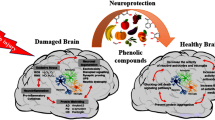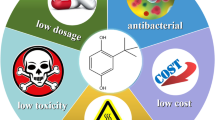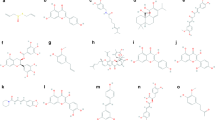Abstract
Oxidative stress contributes to the progression of neurodegenerative diseases of the central and peripheral nervous systems, including Alzheimer’s disease, Parkinson’s disease, stroke, and diabetic neuropathy. Despite the greater capability of peripheral nerves to regenerate compared with those in the brain or spinal cord, chronic oxidative stress leads to irreversible neurodegeneration in peripheral nerves. Thus, many efforts have been made to defend against irreversible peripheral nerve degeneration and oxidative stress. Numerous phytochemicals have been revealed as antioxidants which neutralize free radicals and reduce peripheral neurocellular damage. Among them, polyphenols alleviate neurodegeneration by interacting with reactive oxygen species. Apigenin is a polyphenol found in plant-derived foods, including parsley, thyme, celery, and chamomile tea. Apigenin has been reported to exert antioxidative effects by scavenging free radicals. In particular, apigenin has a neuroprotective effect against oxidative stress in neurological disorders, such as cerebral ischemia. However, to date, no studies have shown an association of the inhibitory effect of apigenin with peripheral nerve degeneration. In this work, we showed that apigenin has a neuroprotective effect against peripheral nerve degeneration according to four key phenotypes: axonal degradation, myelin fragmentation, trans-dedifferentiation, and proliferation of Schwann cells via Krox20- and extracellular signal-regulated kinase-independent processes. Thus, apigenin could be a good candidate to treat peripheral neurodegenerative diseases.






Similar content being viewed by others
References
Ayala A, Muñoz MF, Argüelles S (2014) Lipid peroxidation: production, metabolism, and signaling mechanisms of malondialdehyde and 4-hydroxy-2-nonenal. Oxid Med Cell Longev 2014:360438
Baas PW, Black MM (1990) Individual microtubules in the axon consist of domains that differ in both composition and stability. J Cell Biol 111:495–509
Bizzozero OA, Bixler H, Parkhani J, Pastuszyn A (2001) Nitric oxide reduces the palmitoylation of rat myelin proteolipid protein by an indirect mechanism. Neurochem Res 26:1127–1137
Brown GC, Cooper CE (1994) Nanomolar concentrations of nitric oxide reversibly inhibit synaptosomal respiration by competing with oxygen at cytochrome oxidase. FEBS Lett 356:295–298
Buttke TM, Sandstrom PA (1994) Oxidative stress as a mediator of apoptosis. Immunol Today 15:7–10
Cao C, Dai L, Mu J, Wang X, Hong Y, Zhu C, Jin L, Li S (2019) S1PR2 antagonist alleviates oxidative stress-enhanced brain endothelial permeability by attenuating p38 and Erk1/2-dependent cPLA2 phosphorylation. Cell Signal 53:151–161
Chen M, Wang X, Zha D, Cai F, Zhang W, He Y, Huang Q, Zhuang H, Hua ZC (2016) Apigenin potentiates TRAIL therapy of non-small cell lung cancer via upregulating DR4/DR5 expression in a p53-dependent manner. Sci Rep 6:35468
Cirmi S, Ferlazzo N, Lombardo GE, Ventura-Spagnolo E, Gangemi S, Calapai G, Navarra M (2016) Neurodegenerative diseases: might citrus flavonoids play a protective role? Molecules 21:1312
Czyz J, Madeja Z, Irmer U, Korohoda W, Hülser DF (2005) Flavonoid apigenin inhibits motility and invasiveness of carcinoma cells in vitro. Int J Cancer 114:12–18
Eckersley L (2002) Role of the Schwann cell in diabetic neuropathy. Int Rev Neurobiol 50:293–321
Gupta S, Afaq F, Mukhtar H (2002) Involvement of nuclear factor-kappa B, Bax and Bcl-2 in induction of cell cycle arrest and apoptosis by apigenin in human prostate carcinoma cells. Oncogene 21:3727–3738
Ha SK, Lee P, Park JA, Oh HR, Lee SY, Park JH, Lee EH, Ryu JH, Lee KR, Kim SY (2008) Apigenin inhibits the production of NO and PGE2 in microglia and inhibits neuronal cell death in a middle cerebral artery occlusion-induced focal ischemia mice model. Neurochem Int 52:878–886
Harrisingh MC, Perez-Nadales E, Parkinson DB, Malcolm DS, Mudge AW, Lloyd AC (2004) The Ras/Raf/ERK signalling pathway drives Schwann cell dedifferentiation. EMBO J 23:3061–3071
Husain SR, Cilurd J, Cillard P (1987) Hydroxyl radical scavenging activity of flavonoids. Phytochemistry 26:2489–2491
Jessen KR, Mirsky R (2016) The repair Schwann cell and its function in regenerating nerves. J Physiol 594:3521-3531
Jung J, Cai W, Jang SY, Shin YK, Suh DJ, Kim JK, Park HT (2011) Transient lysosomal activation is essential for p75 nerve growth factor receptor expression in myelinated Schwann cells during Wallerian degeneration. Anat Cell Biol 44:41–49
Kaewkhaw R, Scutt AM, Haycock JW (2012) Integrated culture and purification of rat Schwann cells from freshly isolated adult tissue. Nat Protoc 7:1996–2004
Klaunig JE, Kamendulis LM (2004) The role of oxidative stress in carcinogenesis. Annu Rev Pharmacol Toxicol 44:239–267
Kloska A, Jakóbkiewicz-Banecka J, Narajczyk M, Banecka-Majkutewicz Z, Wȩgrzyn G (2011) Effects of flavonoids on glycosaminoglycan synthesis: implications for substrate reduction therapy in Sanfilippo disease and other mucopolysaccharidoses. Metab Brain Dis 26:1–8
Kobayashi M, Ishibashi S, Tomimitsu H, Yokota T, Mizusawa H (2012) Proliferating immature Schwann cells contribute to nerve regeneration after ischemic peripheral nerve injury. J Neuropathol Exp Neurol 71:511–519
Konat GW, Wiggins RC (1985) Effect of reactive oxygen species on myelin membrane proteins. J Neurochem 45:1113–1118
Korolchuk VI, Menzies FM, Rubinsztein DC (2010) Mechanisms of cross-talk between the ubiquitin-proteasome and autophagy-lysosome systems. FEBS Lett 584:1393–1398
Lee CF, Liu CY, Hsieh RH, Wei YH (2005) Oxidative stress-induced depolymerization of microtubules and alteration of mitochondrial mass in human cells. Ann N Y Acad Sci 1042:246–254
Lee HK, Shin YK, Jung J, Seo SY, Baek SY, Park HT (2009) Proteasome inhibition suppresses schwann cell dedifferentiation in vitro and in vivo. Glia 57:1825–1834
Lloyd AC, Obermüller F, Staddon S, Barth CF, McMahon M, Land H (1997) Cooperating oncogenes converge to regulate cyclin/cdk complexes. Genes Dev 11:663–677
Ma X, Lin W, Lin Z, Hao M, Gao X, Zhang Y, Kuang H (2017) Liraglutide alleviates H2O2-induced retinal ganglion cells injury by inhibiting autophagy through mitochondrial pathways. Peptides 92:1–8
Manthon NF, Malcolm DS, Harrisingh MC, Cheng L, Lloyd AC (2001) Lack of replicative senescence in normal rodent glia. Science 291:872–875
Mao X-Y, Yu J, Liu Z-Q, Zhou H-H (2015) Apigenin attenuates diabetes-associated cognitive decline in rats via suppressing oxidative stress, nitric oxide synthase and anti-apoptotic pathway. Int J Clin Exp Med 8:15506–15513
Martini R, Fischer S, López-Vales R, David S (2008) Interactions between Schwann cells and macrophages in injury and inherited demyelinating disease. Glia 56:1566–1577
Napoli I, Noon LA, Ribeiro S, Kerai AP, Parrinello S, Rosenberg LH, Collins MJ, Harrisingh MC, White IJ, Woodhoo A, Lloyd AC (2012) A central role for the ERK-signaling pathway in controlling Schwann cell plasticity and peripheral nerve regeneration in vivo. Neuron 73:729–742
Newbern JM, Snider WD (2012) Bers-ERK Schwann cells coordinate nerve regeneration. Neuron 73:623–626
Park BS, Kim H-W, Rhyu IJ, Park C, Yeo SG, Huh Y, Jeong NY, Jung J (2015) Hydrogen sulfide is essential for Schwann cell responses to peripheral nerve injury. J Neurochem 2015:230–242
Patel D, Shukla S, Gupta S (2007) Apigenin and cancer chemoprevention: progress, potential and promise (review). Int J Oncol 30:233–245
Pehar M, Cassina P, Vargas MR, Castellanos R, Viera L, Beckman JS, Estévez AG, Barbeito L (2004) Astrocytic production of nerve growth factor in motor neuron apoptosis: implications for amyotrophic lateral sclerosis. J Neurochem 89:464–473
Renno WM, Al-Maghrebi M, Alshammari A, George P (2013) (–)-Epigallocatechin-3-gallate (EGCG) attenuates peripheral nerve degeneration in rat sciatic nerve crush injury. Neurochem Int 62:221–231
Rubbo H, Radi R, Trujillo M, Telleri R, Kalyanaraman B, Barnes S, Kirk M, Freeman BA (1994) Nitric oxide regulation of superoxide and peroxynitrite-dependent lipid peroxidation. J Biol Chem 269:26066–26075
Santin Y, Sicard P, Vigneron F, Guilbeau-Frugier C, Dutaur M, Lairez O, Couderc B, Manni D, Korolchuk VI, Lezoualc’h F, Parini A, Mialet-Perez J, (2016) Oxidative stress by monoamine oxidase-a impairs transcription factor EB activation and autophagosome clearance, leading to cardiomyocyte necrosis and heart failure. Antioxid Redox Signal 25:10–27
Sastre J, Pallardó FV, Viña J (2003) The role of mitochondrial oxidative stress in aging. Free Radic Biol Med 35:1–8
Shin YH, Lee SJ, Jung J (2013) Extracellular ATP inhibits Schwann cell dedifferentiation and proliferation in an ex vivo model of Wallerian degeneration. Biochem Biophys Res Commun 430:852–857
Shukla S, Gupta S (2007) Apigenin-induced cell cycle arrest is mediated by modulation of MAPK, PI3K-Akt, and loss of cyclin D1 associated retinoblastoma dephosphorylation in human prostate cancer cells. Cell Cycle 6:1102–1114
Singh V, Sharma V, Verma V, Pandey D, Yadav SK, Maikhuri JP, Gupta G (2015) Apigenin manipulates the ubiquitin–proteasome system to rescue estrogen receptor-β from degradation and induce apoptosis in prostate cancer cells. Eur J Nutr 54:1255–1267
Svaren J, Meijer D (2008) The molecular machinery of myelin gene transcription in Schwann cells. Glia 56:1541–1551
Topilko P, Schneider-Maunoury S, Levi G, Baron-Van Evercooren A, Chennoufi ABY, Seitanidou T, Babinet C, Charnay P (1994) Krox-20 controls myelination in the peripheral nervous system. Nature 371:796–799
Ujiki MB, Ding X-Z, Salabat MR, Bentrem DJ, Golkar L, Milam B, Talamonti MS, Bell RH, Iwamura T, Adrian TE (2006) Apigenin inhibits pancreatic cancer cell proliferation through G2/M cell cycle arrest. Mol Cancer 5:76
Van Acker SABE, Van Balen GP, Van Den Berg DJ, Bast A, Van Der Vijgh WJF (1998) Influence of iron chelation on the antioxidant activity of flavonoids. Biochem Pharmacol 56:935–943
Wang JT, Medress ZA, Barres BA (2012) Axon degeneration: molecular mechanisms of a self-destruction pathway. J Cell Biol 196:7–18
Wu F, Yao H, Zheng F, Tang S, Lin X, Li L, Zhou J, Li H (2018) Protective effects of honokiol against oxidative stress-induced apoptotic signaling in mouse podocytes treated with H2O2. Exp Ther Med 16:1278–1284
Yan X, Qi M, Li P, Zhan Y, Shao H (2017) Apigenin in cancer therapy: anti-cancer effects and mechanisms of action. Cell Biosci 7:50
Zhao L, Wang JL, Liu R, Li XX, Li JF, Zhang L (2013) Neuroprotective, anti-amyloidogenic and neurotrophic effects of apigenin in an Alzheimer’s disease mouse model. Molecules 18:9949–9965
Acknowledgements
This work was supported by Basic Science Research Program through the National Research Foundation of Korea (NRF) Grant funded by the Korea government (MSIT) (N.Y. Jeong, 2018R1A2B6001123; J. Jung, 2018R1D1A1B07040282; H.J. Chung, 2018R1C1B5029745).
Author information
Authors and Affiliations
Corresponding authors
Ethics declarations
Conflict of interest
The authors declare that there are no conflicts of interest.
Additional information
Publisher's Note
Springer Nature remains neutral with regard to jurisdictional claims in published maps and institutional affiliations.
Rights and permissions
About this article
Cite this article
Kim, M., Jung, J., Jeong, N.Y. et al. The natural plant flavonoid apigenin is a strong antioxidant that effectively delays peripheral neurodegenerative processes. Anat Sci Int 94, 285–294 (2019). https://doi.org/10.1007/s12565-019-00486-2
Received:
Accepted:
Published:
Issue Date:
DOI: https://doi.org/10.1007/s12565-019-00486-2




